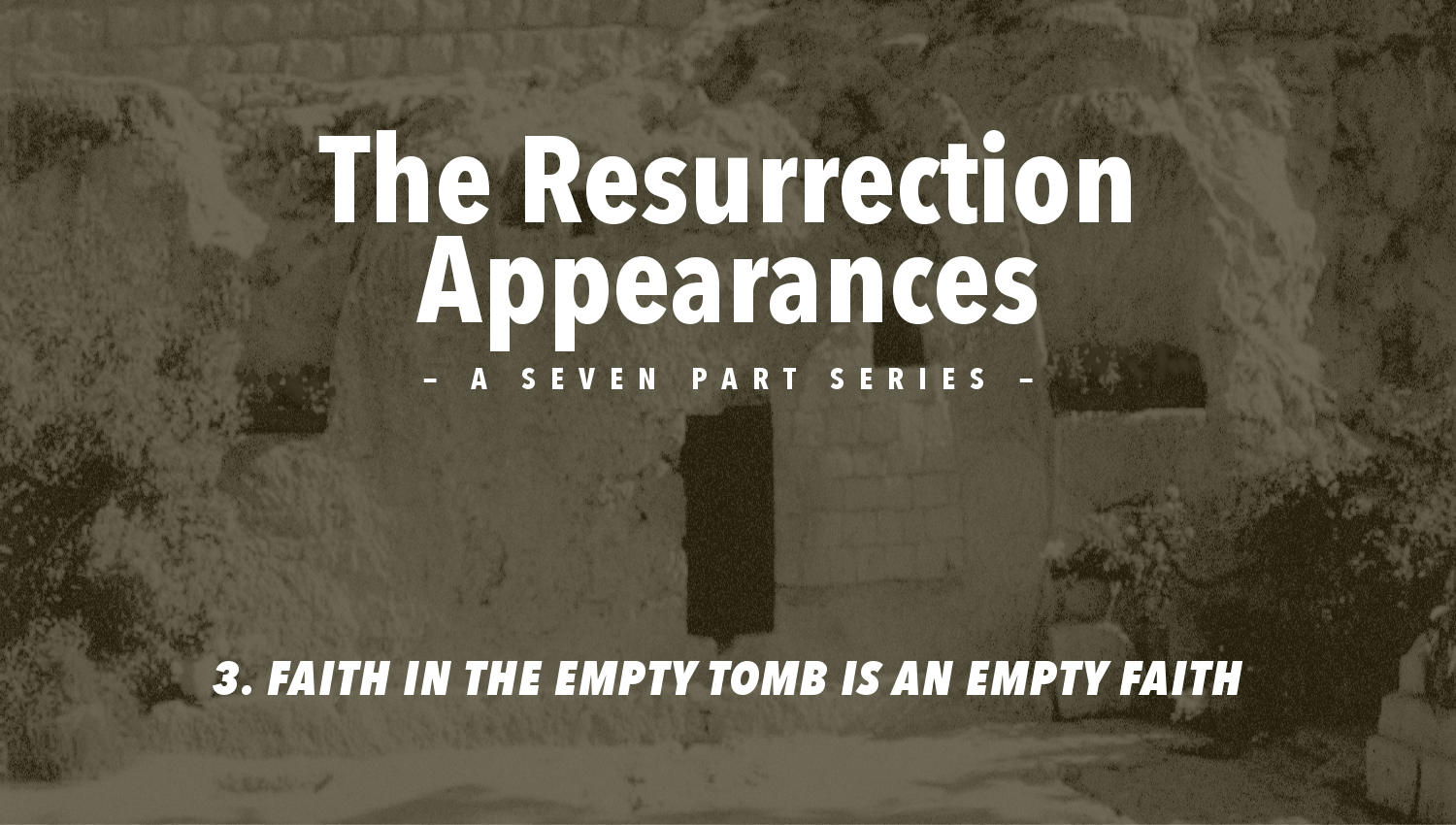
The Resurrection Appearances: A Seven Part Series
Part 3. Faith in the Empty Tomb is an Empty Faith
In part three of the Resurrection Appearances series, I've compiled three theologians who reject the historicity of the empty tomb stories in the New Testament: Wolfhart Pannenberg, Raymond E. Brown, and Karl Barth. All three theologians believe in the bodily resurrection of Jesus Christ, and also believe that if the dead body or skeleton of Jesus were to be discovered in Jerusalem, it would provide irrefutable evidence that the resurrection of Jesus did not happen. However, these three theologians do not believe that the empty tomb stories reported in the New Testament was a historical event. In fact, they all believe that Christians should not believe in an empty tomb, because Christians believe in a living Jesus not the empty tomb, and any fundamentalist statement that says our faith depends on belief in the empty tomb should be ridiculed as an "empty faith" and a "misplaced faith".
Pannenberg, Brown, and Barth believe the empty tomb stories in the New Testament are not historical for the same basic reasons:
First, Paul's resurrection accounts (cf. 1 Cor 15:4) say nothing about the empty tomb, so either Paul did not know about the empty tomb or it was not important to him.
Second, Paul's witness to the resurrection is the oldest tradition in the New Testament, even older than the Gospels that report the empty tomb, and makes no references to the empty tomb.
Third, the oldest witnesses to the risen Jesus are isolated accounts of resurrection appearances that describe the risen Jesus appearing and disappearing as a single event, such as in Paul's conversion on the road to Damascus; and they did not separate the appearing (c.f. empty tomb) and disappearing (c.f. the ascension) by a forty day period.
Fourth, the empty tomb is a specifically a concern for the earliest Jerusalem Christians, because their resurrection stories may be falsified by the discovery of the dead body of Jesus. When the early Christians first shared the resurrection appearances, they were confronted with questions concerning the location of the body of Jesus, and conflicting answers were given (John 20:13-18; Matthew 28:13-15), and the empty tomb story finally developed to answer these questions.
Fifth, the empty tomb story further developed in the oral tradition, were include in the earliest Gospel (Mark 16:1-8), because it was an effective narrative device for codifying the independent resurrection appearances.
Sixth, the empty tomb stories contain contradictions that make a historical reconstruction impossible, (Mark 16:1-8; Matthew 28:1-10; Luke 24:1-12; John 20:1-18; Gospel of Peter 35-43.), and these indicate that the empty tomb stories were still developing in the later gospels, further confirms the legendary nature of the empty tomb stories, and its origin as a narrative and apologetic vehicle for explaining the resurrection appearances.
Seventh, any demand that the empty tomb must be believed, is a modern fundamentalist statement that is open to ridicule, as an "empty faith", because Christians do not believe in an empty tomb, but in a living Jesus Christ. However, even if the empty tomb proves to be legendary in nature, it remains indispensable to the Church's Easter faith, because it is the traditional narrative used by the Church tradition to proclaim the resurrection appearances of Jesus.
Wolfhart Pannenberg's criticism of the Empty Tomb
Wolfhart Pannenberg (1928—2014) says that an empty tomb is not sufficient in itself to prove that the resurrection happened. There are countless empty tombs in the world today, but none of them prove a resurrection had happened. Pannenberg says that the "mere fact of the empty tomb is subject to different interpretations" and even within the New Testament itself (John 20:13-18; Matthew 28:13-15), the empty tomb is interpreted in many ways. So Pannenberg says the empty tomb is secondary to the resurrection appearances, and only "takes on significance for the whole subject only in connection with the [resurrection] appearances." [1]
Pannenberg says in his Systematic Theology, Vol. 2:
Though primitive Christian conviction as to the resurrection of Jesus rests not on the finding of his empty tomb but on the appearances, the tomb tradition is significant for the total witness to the Easter event. It creates difficulty for the theory that the appearances of the risen Lord might have been hallucinations. It also resists any superficial spiritualizing of the Easter message, though leaving room for the thought of a changing of the earthly corporeality of Jesus into the eschatological reality of a new life. We thus cannot explain the finding of the empty tomb as a product of Easter faith, we must still assign to the report the function of confirming the identity of the reality of Jesus encountered in the appearances with his resurrection from the dead. [4]
Pannenberg's criticism of the empty tomb's history is largely based on his belief that Paul's account of the resurrection is older than the gospel reports, and that it lacks the empty tomb, and also describes the resurrection as a single even of appearing and disappearing, as it happened in Paul's conversion on the road to Damascus when he saw the risen Jesus.
Pannenberg says, "the fact that in the oldest NT witness the resurrection and ascension of Jesus form a single event, as in Phil 2:9; Acts 2:36; 5:30f.; the self- declaration of the risen Lord must thus have been from the concealment of heaven." [3]
Pannenberg believed that the empty tomb narratives were only important to the early Jerusalem Christians, because they were in direct proximity to the location where Jesus died. He believed that these Christians preached about the resurrection appearances of the risen Jesus first, but questions arose about the location of Jesus' body, because if the corpse of Jesus were found, their claims about the resurrection of Jesus would be irrefutably disproved. Pannenberg also believed that the empty tomb reports were important to show that the resurrection appearances were not hallucinations. Pannenberg believes the empty tomb stories developed within the gospel traditions only, because Christians in Ephesus or Corinth were not concerned about someone producing a corpse of Jesus to invalidate the Easter Faith.
Pannenberg's essential point is the absence of an empty tomb in Paul's account, indicates that the empty tomb was not part of the initial witnesses to the resurrection, and it is a dispensable feature of the resurrection appearances.
Paul's mention of the burial of Jesus 1 Cor 15:4 tells us nothing regarding his knowledge of the empty tomb. From the fact that he does not expressively mention the empty tomb we cannot infer that he did not know about it, but merely that emphasis on this fact was not theologically important for him as he developed his argument in his epistles. This is not surprising if for Paul the empty tomb was a self-evident implication of what was said about the resurrection of Jesus. Paul found proof of the event in the appearances of the risen Lord, not in the empty tomb. This is understandable in view of the fact that the empty tomb could be explained in different ways. In Jerusalem the empty tomb had to be important as a self-evident fact, but not equally so in Ephesus or Corinth. Furthermore, the fact of the empty tomb has no importance of its own if it is implied already in a raising or rising again or if by itself it cannot sustain the proclaiming of a resurrection. [2]
Raymond E. Brown's criticism of the Empty Tomb
Raymond E. Brown (1928—1998) makes a similar argument against the historicity of the empty tomb in The Virginal Conception and Bodily Resurrection of Jesus. In this book, Brown also believes that the resurrection of Jesus was bodily, but the empty tomb reports in the gospels were legendary (and not historical). Brown's argument is similar to Pannenberg's (and was praised by Pannenberg), and he summarizes as follows:
In the genesis of resurrection faith it was the appearance of the glorified Lord that first brought his disciples to believe; and this belief, in turn, interpreted the empty tomb. Having seen the risen Jesus, they understood that the reason why the tomb was empty was because he had been raised from the dead. Thus Christians confessed a Jesus who both was raised and appeared (1 Cor 15:4-5; Luke 24:34). Consequently, while the empty tomb was not an object of Christian faith, it was not unrelated to that faith, for it colored the way in which the faith was proclaimed. [7]
And,
The tomb of Jesus was not itself part of the eschatological event. Jesus was buried in a certain place. If that place was known, it could have been visited at a certain time. If the tomb was visited and it contained the corpse or skeleton of Jesus, it is difficult, if not impossible, to understand how the disciples could have preached that God raised Jesus from the dead, since there would have been irrefutable evidence that He had not done so (This point is made persuasively by W. Pannenberg). It is therefore reasonably certain that either the tomb was not known, or that, if known, it was empty. [5]
Brown is particularly helpful in highlighting that it is ridiculous to have faith in an empty tomb, such statements are open to ridicule. All belief in an empty casket, is a belief in the nothing that is in that casket, and is no faith at all. Christian faith is in a living person, not in a vacant cave, bare pine box, open six fit pit, or other empty space.
Of itself, then, the empty tomb was probably not at first a sign of the resurrection, and the emptiness of the tomb was not formally a part of the Christian faith in the risen Jesus. Modern fundamentalist statements such as "Our faith depends on the empty tomb" or "We believe in the empty tomb" are not only open to ridicule about the emptiness of one's faith, but also misplace the emphasis in resurrection faith. Christians believe in Jesus, not in a tomb. [6]
Karl Barth's criticism of the Empty Tomb
Karl Barth (1886—1968) also recognized the legendary nature of the empty tomb stories, and although I've already written about Barth's demythologizing the Empty Tomb, it is worth reviewing the following comment from Barth, where says that assent to the empty tomb is an indispensable to the Easter Faith, even if the empty tomb proves to be legendary (or Saga) instead of a historical event. Barth repeats what has already been said again and again, but is still necessary to repeat, that the Christian Faith is in the risen Jesus, not in an empty tomb.
The empty tomb was obviously a very ambiguous and contestable fact (Matt 27:62f; 28:11f). And what has happened around this sepulcher is a warning against making it a primary focus of attention. The empty tomb is not the same thing as the resurrection. It is not the appearance of the Living; it is only its presupposition. Hence it is only the sign, although an indispensable sign. Christians do not believe in the empty tomb, but in the living Christ. This does not mean, however, that we can believe in the living Christ without believing in the empty tomb. Is it just a "legend"? What matter? It still refers to the phenomenon ensuing the resurrection, to the presupposition of the appearance of Jesus. It is the sign which obviates all possible misunderstanding. It cannot, therefore, but demand our assent, even as a legend. Rejection of the legend of the empty tomb has always been accompanied by rejection of the saga of the living Jesus, and necessarily so. Far better, then, to admit that the empty tomb belongs to the Easter event as its sign. [8]
Conclusions on the Empty Tomb
In this post, I've selected three credible and world famous theologians, who are committed to the Christian faith, to explain the problems with the empty tomb reports in the New Testament. I realize these texts are near the core of the Christian Faith, so many readers may not be comfortable with any criticism of them, but I also believe that the Scriptures are a true witness to Jesus, so we must not be afraid of reading them, studying them, and understanding them rightly. Even if the empty tomb reports prove to be legendary, mythical, or saga in genre, that does not disprove the resurrection of Jesus was a fact of history, and it still means that the empty tomb is indispensable to the Church's proclamation of the Easter Faith.
Evangelicals are familiar with bombastic statements regarding the empty tomb, especially from celebrity pastors that declare the Christian Faith requires affirming the historicity of the empty tomb stories. Regardless of the historicity of the empty tomb, these bombastic statements are ridiculous and open to ridicule. Christians believe in a living Jesus, not an empty tomb, and any faith in the empty tomb is an empty and misplaced faith, that has been wrongly shifted from the risen Jesus to a cave of death.
The Resurrection Appearances series:
- The Resurrection Appearances: 1. The Argument for Historical Facticity
- The Resurrection Appearances: 2. Eyewitnesses, Visions or Hallucinations?
- The Resurrection Appearances: 3. Faith in the Empty Tomb is an Empty Faith
- The Resurrection Appearances: 4. The Third Day: A Theological Symbol or a Historical Date and Time?
- The Resurrection Appearances: The Oldest Resurrection Accounts in the New Testament (Part 5)
- Coming soon . . .
Sources:
1. Pannenberg, Wolfhart. Systematic Theology (Volume 2). trans. Geoffrey W. Bromiley, Wm. B. Eerdmans Publishing Co., 2001. Print. 353.
2. Ibid. 359.
3. Ibid. 354-5.
4. Ibid. 359.
5. Brown, Raymond Edward. The Virginal Conception & Bodily Resurrection of Jesus, Chapman, 1974, p. 126-7.
6. Ibid. 126-7.
7. Ibid. 127
8. Barth, Karl. "Church Dogmatics Study Edition 16" Ed. T. F. Torrance and G.W. Bromiley. III.2 The Doctrine of Creation. Trans. G. W. Bromiley. London: T & T Clark, 2010. 17-8. Print. [p453-4]
Header Image: Garden Tomb. Wikipedia. By Phillip Benshmuel - Own work, CC BY-SA 4.0, Link



June 4th, 2018 - 07:01
Your quotes from Pannenberg seem to me to be defenses of historicity of the empty tomb, not critiques of it. Pannenberg is saying that, in a first century Jewish context, “resurrection” necessarily meant “bodily resurrection.” This is hardly Pannenberg saying the empty tomb is legendary — rather he is saying that the empty tomb can be inferred from Paul’s statements in 1 Cor 15:4!
However, I agree with your general sentiment that statements about “faith in the empty tomb” are misguided.
April 28th, 2022 - 12:03
Are these guys nuts without the empty tomb our faith is in vain if they don’t beleve in the empty tomb then was jesus buried
December 30th, 2022 - 20:38
I’m not a Pannenberg nor Barth guy, but I know Fr. Brown a bit, and I think you’ve misinterpreted his statements. Actually, I think all three of these quotes argue not against its historicity but in favor of it. For example, Paul’s account (and indeed all bodily resurrection belief) presupposes an empty tomb even though as you point out rightly, it does not rest on it. The authors you quote, I believe, are all saying that the empty tomb was not sufficient for Easter faith, but I do think they are saying it is a necessary condition or at least implied. Thus we can infer historically the empty tomb given bodily resurrection as a component of Easter faith. This assumes the apostolic faith included bodily resurrection as argued for in Fr. Brown’s book you quote titled ‘The Virginal Conception and Bodily Resurrection of Jesus’.
Btw Fr. Brown was not a theologian in any sense of the word, with no license, no books, and no degree. He was an NT scholar, and in Catholic circles, those are not the same thing.
After one last glance at your article, I am pretty sure Barth is using the same logic I am.